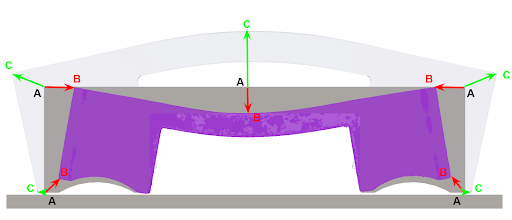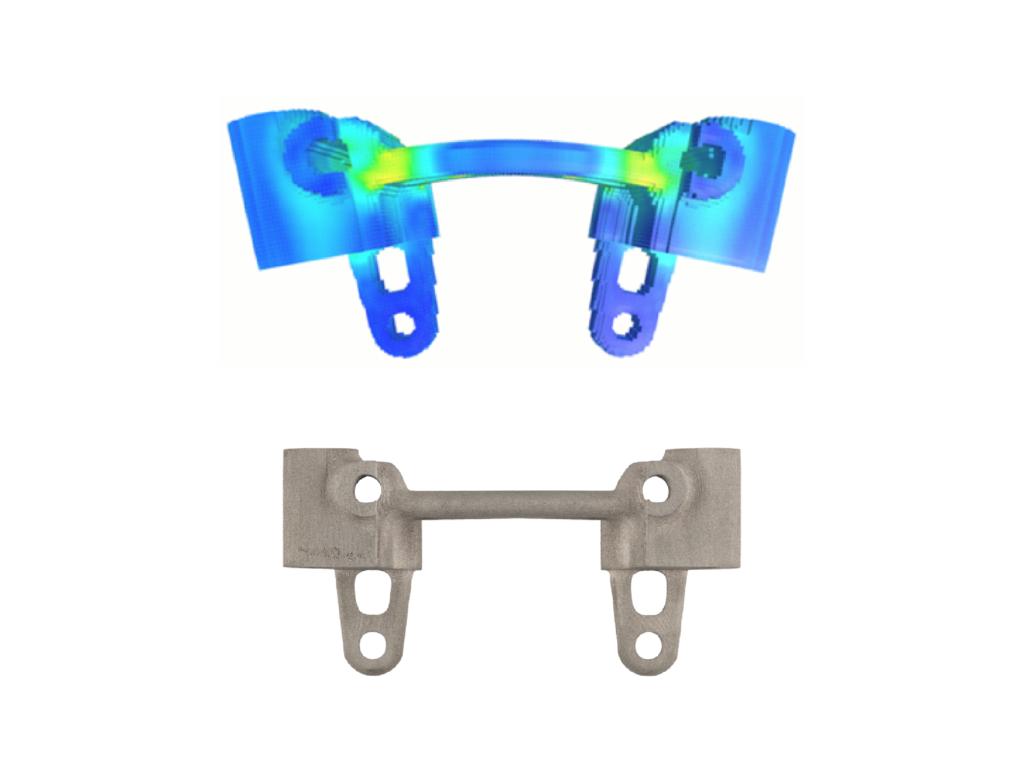Unicorn startup Desktop Metal is the latest in the metal 3D printing space to announce a simulation product. Dubbed Live Sinter, the software is meant to replace the trial and error process associated with bound metal printing, such as its own binder jetting technology.
In metal binder jetting, “green” parts that come out of the printer are first put into a debinding station, where the binding material is removed. They are then sintered in a furnace in order to make them denser and stronger. This process, however, results in shrinkage of up to 20 percent of the original printed dimensions. Other issues that can arise include distortion from features that don’t have the proper support structures. Cracks and deformation can thus require printing the part again or implementing post-processing procedures. The same is true for many parts made with traditional metal injection molding (MIM), which inspired metal binder jetting.
Like much of the metal 3D printing segment, engineers and operators have had to rely on a cumbersome and costly process of trial and error to achieve the proper parts. Live Sinter accounts for a number of these issues by simulating and automatically compensating for shrinkage and distortion through the creation of “negative offset” geometries. Once printed and sintered, these geometries are meant to result in the as-designed component.
The software runs on a GPU-accelerated multi-physics engine that models the interactions of “hundreds of thousands of connected particle masses and rigid bodies.” This is further refined through meshless finite element analysis that analyzes such factors as strain, stress and displacement with which it simulates shrinkage, distortion, risks and failures, making it possible to validate a design before producing it.
“Live Sinter was developed by joining forces with – instead of fighting against – sintering-based challenges. In doing so, the software generates negative offset part geometries that sinter to the intended shapes and dimensional specifications,” said Andy Roberts, Desktop Metal VP of Software. “It also tackles some of sintering’s biggest challenges, such as the use of setters. For years, creating setters that prop up parts in the furnace relied on the intuition of few engineers with years of hands-on experience. Now, the process is easier, more predictable, and more controllable using Live Sinter.”
A sintering cycle can be simulated in as little as five minutes before creating the proper negative offset geometries as quickly as 15 minutes. It can also be used with new materials, sintering hardware and process parameters, if those are added to a workflow later.
Additionally, the software makes it possible to create geometries that would be difficult to sinter without the software. This is accomplished by enhancing the shape and dimensional tolerances of parts. In turn, Desktop Metal suggests it’s possible to produce parts, including those with complex geometries, correctly the first time, thus reducing time and cost associated with printing and post-processing. The company suggests that it is even possible to sinter parts without support structures.
Live Sinter will first be available for Desktop Metal’s Shop System in Q4 2020 and Production System in 2021. The company notes, however, that the tool is suitable for any sintering-based powder metallurgy process. This includes metal injection molding, but, presumably, it might be used with metal binder jetting from ExOne, as well. Desktop Metal suggests that it may offer the software for these processes in the future.
The trial and error process associated with metal binder jetting may involve a different workflow but is one that occurs with nearly all metal 3D printing technologies. Just as the physics that occurs in a sintering furnace are complex and difficult to predict, so too are such techniques as metal powder bed fusion (PBF) and directed energy deposition.
Historically, the solution to this issue has been the use of an array of thermal cameras and other sensors that can be used to detect problems during the build process. However, as metal 3D printing has become increasingly seen as a viable industrial production tool, customers have demanded greater quality control. While most technologies still lack closed-loop print management, we are headed in that direction and simulation software is playing a key role.
As we’ve covered elsewhere, numerous companies are turning to simulation solutions to predict and compensate for problems during the printing process. ANSYS, for instance, acquired 3DSIM for its metal 3D printing simulation software and is seeing it incorporated into EOS metal PBF machines. Other players developing simulation tools for AM are Hexagon, Altair, Siemens, PTC, Materialise. Velo3D has its own simulation technology that, in conjuction with a highly controlled printing process, not only allows for closed-loop metal 3D printing, but also a limited reliance on support structures.
The recent “Opportunities in Additive Manufacturing Software Markets 2020” report from SmarTech Analysis projects that revenues from AM software will reach a massive $3.7 billion by 2027. Simulation will likely be at the heart of this astounding growth and Desktop Metal is demonstrating that it is not only needed in PBF, but in metal binder jetting, as well.
Subscribe to Our Email Newsletter
Stay up-to-date on all the latest news from the 3D printing industry and receive information and offers from third party vendors.
Print Services
Upload your 3D Models and get them printed quickly and efficiently.
You May Also Like
U.S. Navy Lab Uses 3D Printing to Reduce Tooling Lead Time By Over 90%
The F-35 Lightning II Joint Program Office (JPO), responsible for life-cycle management of the key fifth-generation joint strike fighter (JSF) system used by the U.S., its allies, and its partners,...
Etsy Design Rule Change Reduces Selection of 3D Printed Goods
Online marketplace Etsy has implemented a rule change requiring all 3D printed goods on the site to be original designs. The update to the site’s Creativity Standards states, ¨Items produced using...
Honeywell Qualifies 6K Additive’s Nickel 718 for 3D Printed Aerospace & Defense Parts
6K Additive is renowned for manufacturing sustainable additive manufacturing (AM) powder, and offers a wide portfolio of premium metal and alloy powders that include titanium, copper, stainless steel, and nickel,...
MetalWorm Sells WAAM Systems to Research Institutes in Brazil and Malaysia
Turkish WAAM firm MetalWorm has sold a system in Malaysia and another in Brazil. This is an excellent example of a few emerging trends in additive. Firstly, WAAM was experimented...





































